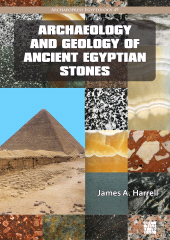Archaeology and Geology of Ancient Egyptian Stones
1098 p.
The ancient Egyptian Civilization dominated the northeast corner of Africa-including modern-day Egypt and, at times, northern Sudan-from about 3000 BC at the beginning of the Dynastic period to AD 642 at the end of the Roman period. Most of what it left behind consists of stones of many kinds. There were building stones for temples, pyramids, mastaba tombs, and other monumental constructions; and utilitarian stones for tools, weapons, and a wide array of mundane applications, including the raw materials for faience, glass, medicines, paint pigments, and pottery. There were also ornamental stones for decorative and structural elements in buildings, obelisks, statues, sarcophagi, stelae, vessels, shrines, offering tables, mace heads, cosmetic palettes, and other sculpted objects; and gemstones for jewellery, amulets, seals, and other small decorative items. Still more stones were processed to extract their metals, including gold, copper, iron, and lead. Two persistent problems in Egyptology have been the geolog
ical identification of these stones, and the recognition of their sources. Archaeology and Geology of Ancient Egyptian Stones seeks to identify and describe all the rocks and minerals employed by the ancient Egyptians using proper geological nomenclature, and to give an account of their sources in so far as they are known. A secondary objective is to describe the multitudinous uses of the stones as well as the technologies employed to extract, transport, carve, and thermally treat them. [Publisher's text].
Special access authorizations may apply; please contact us for further information.
-
Información
ISBN: 9781803275826
COLECCIÓN


